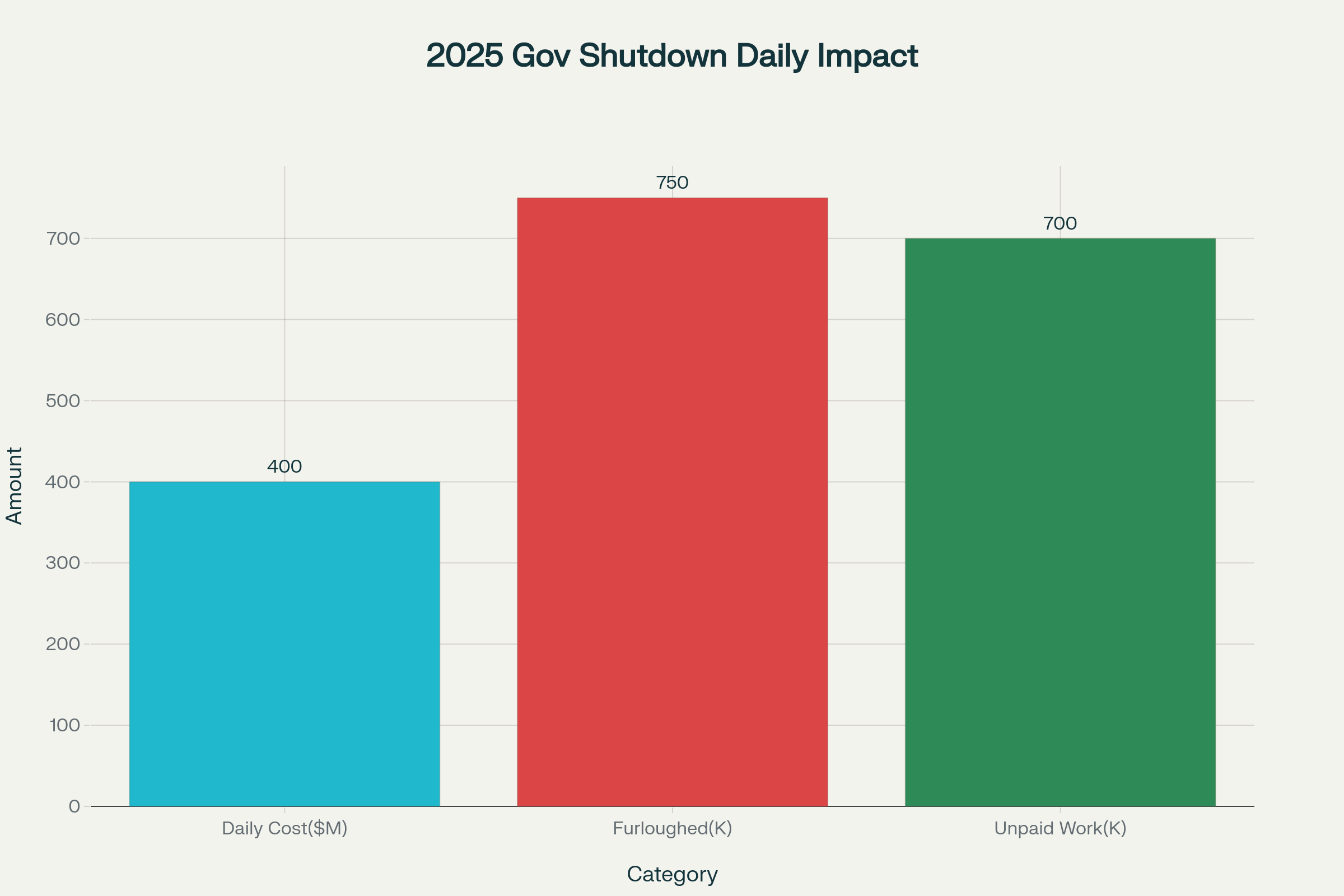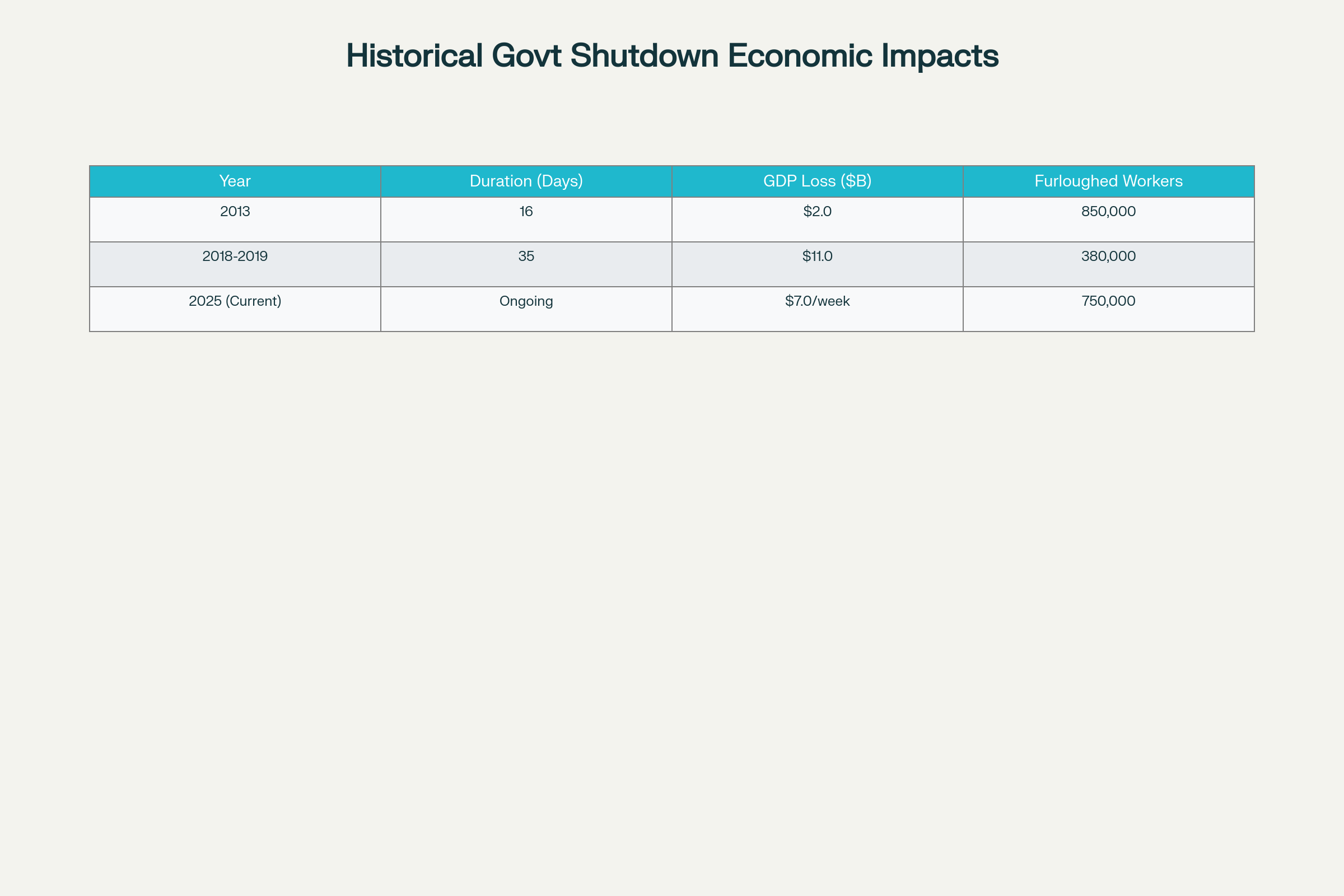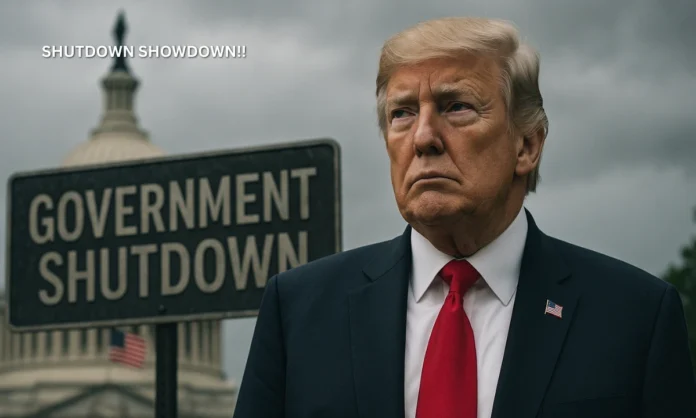Key Highlights
- President Trump plans to meet with Budget Director Russell Vought to determine which federal agencies to cut permanently during the government shutdown
- 750,000 federal workers are furloughed daily while 700,000 others work without pay, costing $400 million in daily compensation
- Democrats demand renewal of health insurance subsidies affecting 22 million Americans, while Republicans refuse to negotiate on additional measures
The United States government shutdown has reached its third day as President Donald Trump signals his intention to leverage the crisis for permanent federal government restructuring. The government shutdown began at 12:01 AM EDT on October 1, 2025, marking the eleventh government shutdown in U.S. history and the third under Trump’s presidency. Unlike previous government shutdown events that focused on temporary funding disputes, this shutdown represents a fundamental disagreement over the role and size of federal government, with Trump viewing it as an unprecedented opportunity to implement his vision of reduced federal operations.
The immediate trigger for this shutdown stems from congressional failure to pass appropriations legislation for fiscal year 2026, but the underlying tensions reflect deeper partisan divisions. Republicans control both houses of Congress but lack the 60 Senate votes needed to pass spending legislation without Democratic support, giving Democrats leverage in negotiations despite their minority status. The shutdown has effectively paralyzed non-essential federal services while highlighting the growing political weaponization of budget disputes in the Trump era.
BREAKING: Trump is STANDING FIRM against Schumer and has no fear of a government shutdown, because it will be THEIR FAULT!
— Gunther Eagleman™ (@GuntherEagleman) September 19, 2025
"I think we could very well end up with a closed country for a period of time. We’ll take care of the military and take care of Social Security, we’ll take… pic.twitter.com/YbYhriqGVK
Strategic Federal Agency Restructuring Under Government Shutdown Conditions
Trump’s approach to this shutdown differs markedly from historical precedents, as he explicitly frames the shutdown as an opportunity to eliminate what he terms “Democrat Agencies.” The President announced his intention to meet with Office of Management and Budget Director Russell Vought to determine which federal agencies should face permanent cuts rather than temporary suspensions during the shutdown. This shutdown strategy represents a calculated effort to use the funding crisis as leverage for implementing broader conservative policy objectives that might otherwise face congressional resistance.
Vought, who co-authored the Heritage Foundation’s Project 2025 and previously served as OMB director during Trump’s first term, has already signaled aggressive implementation of workforce reductions beyond typical furlough procedures during the shutdown. The OMB has instructed federal agencies to prepare comprehensive layoff plans for programs “not aligned with the president’s priorities,” fundamentally altering the traditional approach to government shutdown management. This shutdown thus serves as both a budget dispute and a mechanism for advancing Trump’s broader agenda of federal government downsizing.
The administration has already demonstrated its willingness to use the government shutdown for targeted political purposes, with Vought announcing the freezing of $18 billion in infrastructure projects specifically in New York, home to Democratic leaders Chuck Schumer and Hakeem Jeffries. This selective targeting during the government shutdown suggests a deliberate strategy to pressure Democratic strongholds while protecting Republican priorities, marking a significant departure from the traditionally non-partisan administration of government shutdown protocols.
Economic and Workforce Impacts of Extended Government Shutdown
The current government shutdown is affecting approximately 1.5 million federal employees, with 750,000 workers furloughed daily and another 700,000 classified as essential personnel working without pay. According to Congressional Budget Office estimates, the daily compensation cost for furloughed workers alone reaches $400 million, creating substantial economic pressures that compound with each day the shutdown continues. These figures represent a significant portion of the federal civilian workforce, which totals approximately 2.4 million employees across all agencies and departments.
Economic analysts project that each week of the shutdown could cost the American economy $7 billion and reduce GDP growth by 0.1 percentage points. The Congressional Budget Office’s analysis of the 2018-2019 government shutdown, which lasted 35 days, found that while most economic activity was eventually recovered, approximately $3 billion in GDP was permanently lost. The current shutdown threatens even greater economic disruption given the administration’s stated intention to implement permanent workforce reductions rather than temporary furloughs.
Essential services continue operating during the shutdown, including air traffic control, Transportation Security Administration screening, and law enforcement, though these workers face delayed compensation. However, the shutdown has already begun affecting non-essential services, with federal museums and monuments closing to visitors while others remain open through alternative funding mechanisms. The Smithsonian Institution, which attracts nearly 17 million visitors annually, has sufficient reserves to operate for approximately one week before facing closure due to the government shutdown.

The broader economic implications of this government shutdown extend beyond immediate federal operations, as reduced federal spending traditionally leads to decreased private sector demand for goods and services. Treasury Secretary Scott Bessent has warned that the government shutdown could adversely affect U.S. economic growth, stating that “shutting down the government and decreasing GDP” is not an appropriate method for engaging in policy discussions. The extended nature of this government shutdown, combined with the administration’s permanent restructuring agenda, creates additional uncertainty that could amplify negative economic effects.
Healthcare Policy Disputes at the Center of Government Shutdown Negotiations
The government shutdown centers significantly on healthcare policy disagreements, particularly regarding the fate of enhanced Affordable Care Act premium tax credits affecting 22 million Americans. These subsidies, originally authorized under the American Rescue Plan Act in 2021, are scheduled to expire at the end of 2025, potentially causing healthcare premiums to more than double for marketplace enrollees. Democrats have made renewal of these healthcare subsidies a non-negotiable demand for ending the government shutdown, while Republicans refuse to include any additional provisions beyond basic government funding.
If the enhanced premium tax credits expire as scheduled, approximately 7.3 million Americans could lose their subsidized ACA health coverage, with 4.8 million becoming completely uninsured. According to KFF analysis, average premium payments for marketplace enrollees would increase by approximately 79 percent, creating substantial financial burdens for middle and lower-income households. The government shutdown thus represents not only a budget dispute but a fundamental disagreement over healthcare policy that could affect millions of Americans regardless of the eventual resolution.
Simultaneously, the government shutdown occurs against the backdrop of Trump’s “One Big Beautiful Bill” legislation, which implemented nearly $1 trillion in Medicaid cuts over ten years. These reductions, which primarily affect children and low-income adults, are projected to result in 7.5 million Americans losing Medicaid coverage by 2034 according to Congressional Budget Office estimates. The combination of potential ACA subsidy expiration and existing Medicaid cuts creates a healthcare policy crisis that extends far beyond the immediate government shutdown negotiations.
The healthcare dimensions of this government shutdown particularly affect children’s hospitals and safety-net providers, which rely heavily on Medicaid reimbursements for operational funding. Phoenix Children’s Hospital, for example, derives approximately half its revenue from Medicaid programs, making it vulnerable to both the immediate disruptions of the government shutdown and the longer-term effects of federal healthcare spending reductions. This dual pressure illustrates how the government shutdown amplifies existing policy tensions in ways that extend beyond federal employment into broader social service provision.

Congressional Dynamics and Government Shutdown Resolution Prospects
The path to ending this government shutdown remains unclear as both parties maintain firm positions on their core demands. Republicans need eight Democratic senators to join them in passing a clean funding bill, while Democrats require 13 Republican senators to support their version that includes healthcare subsidy extensions. The last Senate vote on Wednesday saw only three Democrats joining Republicans, indicating the significant political gap that must be bridged to resolve the government shutdown.
House Speaker Mike Johnson has labeled the crisis a “Democrat shutdown” and refuses to negotiate on including insurance subsidies or other Democratic priorities in government funding legislation. Conversely, House Minority Leader Hakeem Jeffries accuses Republicans of deliberately denying healthcare access to working-class Americans and criticizes Trump’s threats to implement permanent federal workforce reductions during the government shutdown. These dueling narratives reflect the deeper partisan divisions that have transformed routine budget negotiations into high-stakes political battles.
Public opinion polling suggests Americans are largely divided along partisan lines regarding responsibility for the government shutdown, with majorities of both Democratic and Republican respondents blaming the opposing party. However, 41 percent of independent voters assign equal blame to both parties, indicating potential political risks for both sides if the government shutdown extends significantly. Historically, extended government shutdowns have created public pressure for resolution once ordinary Americans begin experiencing direct impacts on government services they rely upon.
Congressional leaders are expected to attempt another resolution vote on Friday afternoon, though significant compromises appear necessary for any successful outcome. The government shutdown resolution may ultimately depend on external pressures, such as airport delays from Transportation Security Administration staffing shortages or broader economic impacts that force political leaders to prioritize immediate crisis management over longer-term policy objectives. Until such pressures materialize, the government shutdown appears likely to continue as both parties test their political leverage and public support.
Closing Assessment
The October 2025 government shutdown represents more than a typical budget dispute, serving as a strategic tool for implementing broader federal government restructuring under the Trump administration. With 750,000 federal workers furloughed daily and economic costs mounting at $7 billion per week, this government shutdown threatens significant economic disruption if extended. The healthcare policy dimensions, particularly the expiration of ACA subsidies affecting 22 million Americans, add urgency to resolution efforts while highlighting fundamental disagreements about the federal government’s role in social policy. As congressional leaders prepare for Friday’s resolution attempt, the government shutdown continues to exemplify the increasingly partisan nature of American budget politics and the growing willingness of both parties to risk economic consequences for policy leverage.


